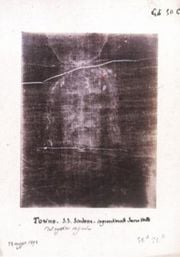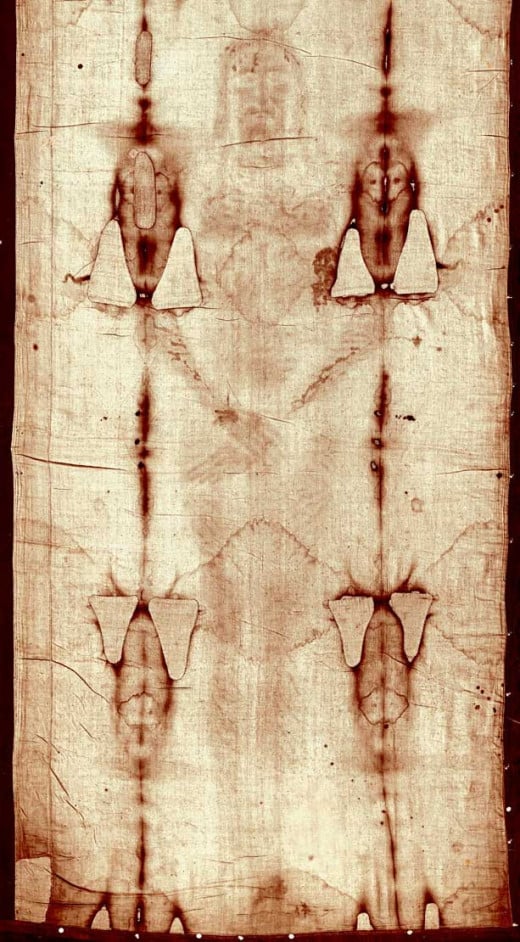Dating of the Shroud of Turin

Should the Shroud of Turin be dated again?
The Shroud of Turin is a uniquely woven cloth of unknown origin that has long been claimed to be the burial shroud of Jesus Christ. The most notable quality of the shroud is the image of a seemingly crucified man’s body on the fabric. After many years of dispute over he age, we now have radiocarbon dating technology, which gives scientists the ability to determine the actual age of the shroud. After much consideration, a sample was cut from the shroud. It was then separated into three samples for dating at three different labs using accelerated mass spectrometry (AMS), a technique that accelerates particles and counts the number of carbon isotopes, which scientists can use to determine the age of an object1. This was all heavily monitored and regulated, both by video and photography, as well as by representatives of different groups such as an Archbishop and several scientists, in order to insure unbiased and accurate results1. The results indicate that the shroud is from AD 1260-1390, with at least 95% confidence, concluding that it is not actually from the time of Jesus Christ1. Nonetheless, there is still disagreement concerning the date of the cloth, and some people would like the Shroud of Turin to be dated again, hoping that the date will agree with their belief that the shroud covered Jesus Christ. Under the current circumstances, I do not believe the shroud should be dated again.

The Shroud of Turin is a finite resource, as well as a historical artifact. To continue dating it would mean slowly destroying it, piece by piece. While I agree that it was necessary to take several samples for the initial dating, it would be unreasonable to continue further dating of the shroud until everyone is happy. Further, how many more samples need be dated before those who disagree finally relent and accept the scientifically, rather than anecdotally, backed age? All three samples that were dated at the three different labs yielded statistically similar results1. They used three control samples of known ages to ensure proper dating techniques and against which they could compare results from the shroud. All of the control results are very accurate, making it unlikely that shroud results are over 1000 years away from the true date, as some would suggest.
Some voices of opposition bring up valid arguments. At one point, the shroud endured a fire while folded inside of a silver case. Kouznetsov et al. claimed that the fire might have changed the amount and type of carbon within the fabric2. However, he overstepped his boundaries by claiming to perform an experiment that yielded literally impossible results3. To make matters even worse, there is reason to believe that Kouznetsov did not even have the equipment to carry out the tests that he claimed to have done. This takes away all of his credibility, making both him and his results fraudulent. Furthermore, his concerns about the fire potentially altering the accuracy of the dating were shown to be unfounded in two separate studies, one by Jull et al.3 and the other by Long 4. Therefore, it is very unlikely that any fire would have significantly changed the results of the radiocarbon dating performed.
Another variable that some were afraid may have altered the radiocarbon dating results is the presence of silver while the shroud was surrounded by fire. Luckily, dating was done on samples similar to the shroud that recreated the presence of silver during a fire5. They found that, similar to heat alone, silver would not significantly affect the accuracy of radiocarbon dating.
A third dissenter argues that the initial samples of the Shroud of Turin were taken from patches that were added on later and not a part of the original shroud6. Although it is true that there are more recent patches incorporated into the shroud, his claims have no logical basis. The samples were taken with multiple people in the room, including two textile experts, representing several different organizations in order to make sure no fraud was committed in the favor of one group1. In addition, the entire process was videotaped to further reduce the likelihood of foul play. The people in charge of taking the samples cut fabric that appeared to be far away from any burn marks or new patches, obviously aiming to get the most pure samples of the shroud as possible. There is no reason to believe that the samples were taken from anything but the fabric in question.
At this point in time, I believe that all of the known testable variables that could have potentially affected the dating of the Shroud of Turin have been tested, and the results support the fact that the initial AMS dates are as accurate as possible. Therefore, there is no reason to conduct further studies. However, if new information were to present itself, such as previously unconsidered factors that may have altered the carbon content, or if new technology becomes available that is able to carbondate more accurately without sacrificing too much of the fabric, then I think we should be open to redating the shroud. This is not because I think the previously found dates are incorrect; rather, it is because I am not opposed to gathering more information to strengthen the argument behind the age of the shroud and gain more insight into the circumstances around which it was created.
References
- Damon, P. E. et al. Radiocarbon Dating of the Shroud of Turin. Nature 337, 611-15 (1989).
- Kouznetsov, D. A., Ivanov, A. A. & Veletsky, P. R. Effects of fires and biofractionation of carbon dating isotopes on results of radiocarbon dating of old textiles: the Shroud of Turin. Journal of Archaeological Science 23, 109-121 (1996).
- Jull, A. J. T., Donahue, D. J., & Damon, P. E. Factors Affecting the Apparent Radiocarbon Age of Textiles: A Comment on “Effects of Fires and Biofractionataion of Carbon Isotopes on Results of Radiocarbon Dating of Old Textiles: The Shroud of Turin,” by D. A. Kouznetsov et al. Journal of Archaeological Science 23, 157-160 (1996).
- Long, A. Attempt to Affect the Apparent 14C Age of Cotton by Scorching in a CO2 Environment. (1998).
- Hedges, R.E.M., Van Klinken, G. J, and Ramsey, C.B.. An Experiment to Refute the Likelihood of Cellulose Carboxylation. (1998).
- Rogers, R.N. Studies on the Radiocarbon Sample from the Shroud of Turin. Thermochimica Acta 425, 189-194 (2005).
Your Turn
Should the Shroud of Turin be dated again?
Related Essays
- Domestication of the Horse in Eurasia
Genetic models, bone tools, damaged horse teeth, refined bone structures, and pottery with animal fat residue provide evidence for the Botai people in Eurasia as the first to domesticate horses. - Ancient Ice Man's Last Meal
Analysis of techniques used to determine the famous ancient Ice Man's last meal.









